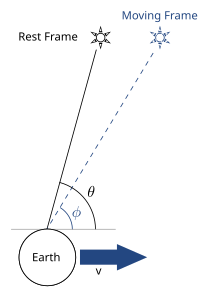User:Ahalda/sandbox

The aberration of light (also referred to as astronomical aberration or stellar aberration) is a relativistic phenomenon important in astronomy which causes objects viewed by moving observers to appear displaced towards the direction of the observer's motion compared to when the observer is stationary, much like falling rain appears to come from ahead to observers in a moving vehicle. The change in angle it causes typically small, on the order of v/c where c is the speed of light and v is the observer's velocity. Aberration's main astronomical effect is "annual" aberration, which causes stars viewed from the Earth over the course of a year to appear to move in the sky in small ellipses with an angular radius of approximately 20 arcseconds, due to the finite speed of light relative to motion of the Earth as it revolves around the Sun.
Historically, aberration led to many developments in the theories of heliocentrism, light, luminiferous aether, electromagnetism and Special Relativity. It was first observed around 1670 by astronomers such as Robert Hooke and John Flamsteed who were instead searching for stellar parallax, who misunderstood it. In 1729 James Bradley provided the classical explanation for it in terms of the finite speed of light relative to the motion of the Earth in its orbit around the Sun, and his results were widely considered "the most brilliant and useful of the century". His theory and observations of aberration provided the first empirical proof of heliocentrism, convinced the scientific world that the speed of light is finite, allowed him to make one of the earliest measurements of the speed of light, and became evidence in the 18th century debate between the corpuscular and wave theories of light. Through his studies of aberration, Bradley also discovered the nutation of the Earth and developed a meticulous approach to experimental science for which he has been called "the inventor of modern science".
In the 19th century aberration initiated a second line of research which ultimately led to the theory of Special Relativity, after Thomas Young theorized that aberration implied the existence of an "aether wind" in 1804, and after François Arago attempted to measure variations in the speed of light using aberration in 1810 but did not detect any, in contradiction with classical theory. These observations inspired the aether drag theories of Augustin Fresnel (in 1818) and G. G. Stokes (in 1845), they motivated new experiments such as the Fizeau and Michelson-Morely experiments, and led to extensions to electromagnetic theory culminating in Hendrick Lorentz' electromagnetic aether theory in 1892. Based on Lorent'z theory Albert Einstein developed the theory of Special Relativity in 1905, which conclusively explained aberration, and he cited aberration as one of the experimental results which most influenced him.

